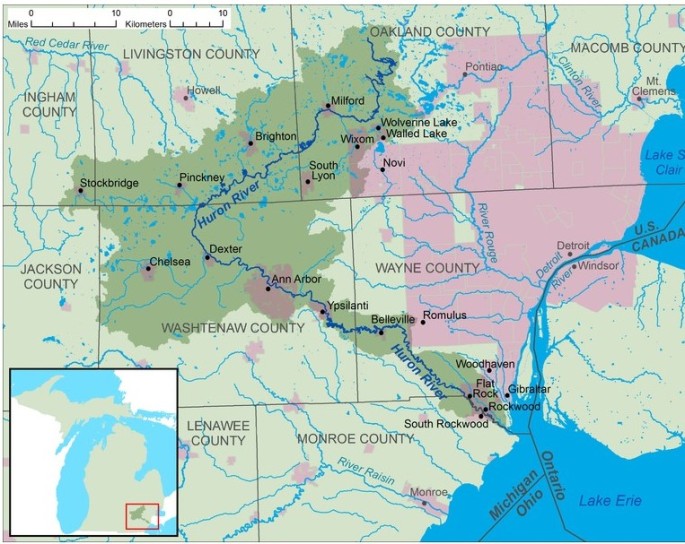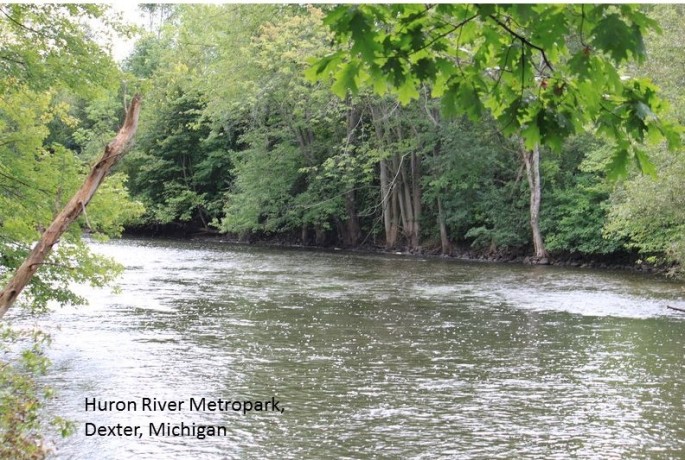
Part of a network of trade routes, The Huron River was named for a Native American nation living in southeastern Michigan. The Huron also called the Huron River the Giwitatigweiasibi.
Rising out of the Huron Swamp in Indian Springs Metropark in northern Oakland County, the Huron River carves a 130 mile course through southeastern Michigan passing through the cities of Dexter, Ann Arbor, Ypsilanti, Belleville, Flat Rock and Rockwood as well as thirteen parks, game and recreation areas. After flowing through Oakland, Livingston, Washtenaw, Wayne and Monroe Counties, it empties into Lake Erie on the boundary between Wayne and Monroe Counties.
Featuring 24 major tributaries for a total of 370 miles in addition to the mainstream, the Huron river watershed drains 908 square miles and the river is designated a Scenic Natural River of southeast Michigan. The Huron River flows through many parks and it is an excellent canoeing river with a relatively slow current and just a few rapids. Fishermen congregate on the river to try their luck at catching its variety of fish including rock bass, sunfish, bluegill, largemouth bass, walleye, catfish, carp, trout, Muskie, and Coho and Chinook salmon below Belleville Dam.
Father Dilhet and Reverend Finley Visit the Huron River
French priest Father Jean Dilhet visited the Huron River in 1798 as part of his parish duties and he named the outcropping of limestone rock on the south side of the Huron Rive, “Grosse Roche,” or Flat Rock. Father Dilhet wrote that he often despaired of convincing the inhabitants of the Huron and Raisin River regions that they needed to give up their partying ways in favor of more sober, responsible lives, but he told his superiors that he would continue to preach, exhort, and pray.[1]
A little more than two decades later, Reverend J.B. Finley described the Huron River as it looked on Sunday, December 14, 1823. He said that he and his party arrived on the Huron River on the Wyandotte reserve of eight sections and found a formidable difficulty. He wrote that “the river was just fordable and frozen on both sides for two or more rods. We alighted, took our tomahawks and cut the ice; then jumped our horses down into the water, got on and rode to the ice on the opposite shore. Here we sat on our horses and cut the ice, when the water was more than misdeeds deep, and I think a colder day I hardly ever experienced. After staying in the water nearly half an hour, we got on the ice and were not out of the water ten minutes before our clothes were frozen stiff.”[2]
Canals, Mills, and Metroparks
On March 23, 1833, a state act incorporated the Huron Canal and Manufacturing Company with a capital of $75,000 to complete a canal connecting the waters of the Huron and Detroit Rivers at Truago, (Trenton) to be completed by April 1, 1841. The board of directors consisting of A.C. Traux, S.B. Campbell, Henry Bennett, N. Dustin and C.N. Bennett unsuccessfully oversaw the canal building in the first of several such failed attempts.
Navigating and damming the Huron River proved to be more successful than connecting canals to it. Congress declared the Huron River navigable in the 19th Century and until the railroads penetrated the region, flat boat traffic plied from Ypsilanti to Lake Erie. Mills dotted the Huron River banks and by the 1880s its waters furnished power to countless mills and at least 17 mill dams.
Flour mills were the most plentiful, but saw mills and woolen mills provided power for wood and wool production. At the beginning of the 20th century, the Detroit Edison Company and the Ford Motor Company acquired and developed dams along the river to produce electric power. By the 21st century, the Huron River had many dams, 19 on its mainstream and more than 96 in the entire watershed, which were built to increase and maintain water levels in surrounding lakes, uses which became environmentally controversial. At least a dozen of the dams were built for mill or hydroelectric power, forming large lakes behind them.

Monitoring the Huron River
As with many Southeastern Michigan rivers, the Huron River has its share of pollution problems, from phosperous, animal waste, chemicals to sewage contamination. Environmentalists continuously study the Huron River to identify and work to eliminate pollutants and monitor the water quality. The Huron River Watershed Council conducts a Water Quality Monitoring program with its partners
A Water Quality Monitoring Program is conducted for the partners in the Middle Huron Initiative (MHI), Livingston Watershed Advisory Group (WAG) and the Alliance of Downriver Watersheds (ADW) to better understand nutrient and contaminant loading dynamics in the Huron River Watershed. The program also aims to identify pollutant loading hot spots and evaluate collective progress of best management practices designed to minimize storm water related impairments.
Overall, the program’s long term goal is to evaluate progress toward improving overall water quality within the Huron River Watershed. The Water Quality Monitoring Program was developed to respond to community interest in collecting data from the Huron River and its lakes and tributaries that would lead to a better understanding of pollution of the watershed. The Monitoring Programs is also designed to reinforce monitoring from other agencies including municipalities, universities, and the Michigan Department of Environmental Quality. In 2009, faculty and students from the University of Michigan produced a multimedia presentation including dance, poetry, music and projects images exploring the Huron River and its impact on the communities along its banks.
River Ripples
Bessemer Herald, Bessemer, Michigan
August 20, 1898
The Huron River has become low and a bad smell arises from its waters along the banks. Large numbers
Ironwood Daily Globe
October 7, 1920
A Brighton man of 80 makes a yearly canoe trip down the Huron River about this season, paddling, fishing, and camping on the banks for two weeks at a stretch. What a splendid thing to do! It is the memories stored up in healthful outdoor adventures like this that we always enjoy most in later years.
Bessemer Herald
September 4, 1909
Dead fish floated down the Huron River in such numbers that it was necessary for the Metler Mills at Flat Rock to shut down to permit the mass to pass through the mill race. There were thousands of fish of all kinds in the mass.
Evening Chronicle, Marshall, Michigan
May 27, 1914
On way to Indianapolis Memorial Day Races when Machine Struck Bridge
Unidentified Man thrown Into River. One Girl had Skull Fractured
Flat Rock, Mich. May 27. One man was killed and four persons, including two young women, injured when an automobile baring a party of five Detroiters to the Indianapolis Memorial Day Race was wrecked at a bridge over the Huron River. The body of the man who was killed was thrown into the river when the machine collided with the bridge railing and has not been recovered. His identity is not known.
Miss Daisy Grove sustained a fractured skull when she was thrown from the car to the bridge. She was taken to the Emergency Hospital in Wyandotte where her condition is reported to be critical. Gertrude Grove, sister of Daisy, is also in Emergency Hospital with a broken collar bone.
The other injured were treated by a local physician and were able to return to Detroit. Their names were not learned.
Evening Chronicle, Marshall, Michigan
September 2, 1922
Eleven Park Sites, 627 Acres in All, Are to be Presented to State
Donations to be made in memory of the late John F. and Horace E. Dodge
Detroit, Sept. 2. Eleven park sites, 627 acres in all, are to be presented to the state of Michigan by the Dodge brothers, Detroit motor car manufacturers, it was announced today. Howard B. Bloomer, chairman of the board of directors of the Dodge Company, said the parks were to be awarded in memory of the late John F. and Horace E. Dodge. The gifts which have been accepted in a letter by Governor Grosbeck included 30 acres of the Huron River Drive on the Huron River, adjacent to the Village of Rockwood, Monroe County.
Bessemer Herald, Bessemer, Michigan
August 26, 1911
Ann Arbor—Percy Raymond, a youngster, after a terrific struggle succeeded in catching a 20 pound carp below the dam in the Huron River. Furthermore, he caught it without a line or hook in his bare hands.
Raymond in company with several other youngsters was playing below the dam when he noticed a big fish stranded on a shoal. The water in the River is unusually low just now because of repairs being made on the dam and the letting out of most of the water, and there was no difficulty in reaching the fish. Several of them attempted to push it up and found themselves foundering in the water where the big fish had landed them. It seemed that the fish would get away until young Raymond jumped onto its back and grabbed its gills. It was one of the biggest fish ever taken out of the Huron.
Notes
[1] Jean Dilhet. Rev. Patrick William Browne, S.T.D. Washington D.C.: The Salve Regina Press, 1922
[2] The Wyandotte Mission at Upper Sandusky, Ohio. Methodist Episcopal Church. By James B. Finley
